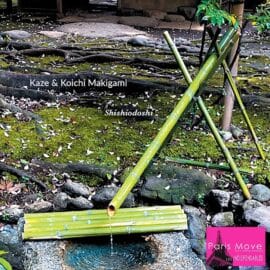| Jazz |

A Surreal Soundscape: Kaze and Koichi Makigami’s ‘Shishiodoshi’ Defies Convention
This is an uncompromising album,radical, enigmatic, and crafted for a select audience. It will likely appeal only to seasoned listeners and devotees of the adventurous Japanese trumpeter Natsuki Tamura. Yet even they may be taken aback by the vocal acrobatics of Koichi Makigami, whose theatrical delivery stretches the limits of expectation. The album conjures a mood that feels almost painterly, evoking the surrealist brushstrokes of Salvador Dalí, where absurdity intermingles with a form of distorted classicism, creating an aesthetic both unsettling and sophisticated.
Kaze, the cooperative quartet composed of the formidable Japanese pianist and composer Satoko Fujii, trumpeters Natsuki Tamura and France’s Christian Pruvost, and drummer Peter Orins, joins forces with Makigami, a living legend of Japanese avant-garde rock and free improvisation, for Shishiodoshi. The result is a bold, inspired collision of disciplined musicianship and eccentric theatricality.
“We had so much fun making this record,” says Fujii. “Koichi brought something truly unique to our music, it pushed us to play differently.”
Though Kaze and Makigami first crossed paths years ago at Jazz Art Sengawa, an experimental festival under Makigami’s artistic direction, it wasn’t until early 2024 that they finally shared a stage, during Kaze’s tour of Japan. When Fujii learned Makigami would be in Europe later that spring, she extended an invitation for him to join Kaze for a concert in Lille, the hometown of Pruvost and Orins. That singular performance would evolve into this record.
What emerges is an album driven by theatricality, its dramaturgy as unruly as it is immersive. Every instrument acts not only as a sound source but as a character on stage, blurring the line between set and performer. The music seems to demand visual presence, this is perhaps a work more meant to be experienced live than consumed passively through headphones. It is an artwork in motion, like nature itself, or the convivial chaos of a long, wine-soaked conversation among friends, punctuated by laughter and spontaneity.
Shishiodoshi features only three tracks, each a sprawling composition stretching beyond the twenty-minute mark, making them wholly unsuitable for radio formats. This is not a compromise, but a declaration: only works of deep artistic intention dare to exist in such unconstrained form.
The album’s title track, “Shishiodoshi,” hits like a revelation, a piece that seems to cry out for choreography, staging, witness. It is visual music at its most intense. Both musicians and listeners must summon a kind of emotional magnitude to grapple with its force. This is the kind of art that nudges all other art forward, that fertilizes the imagination. One listens, and questions arise. Images appear. Ideas take form.
To fully understand the depth of this collaboration, a glance at the artists’ backgrounds is essential:
Satoko Fujii, described by The New York Times as “an improviser of volcanic intensity with a delicate touch,” has been fusing jazz, contemporary music, rock, and Japanese traditions into a singular voice for nearly three decades.
Natsuki Tamura is a trumpeter with a voice entirely his own. Merging jazz lyricism with extended techniques, he leads several ensembles, including Gato Libre and Junk Box, and has released seven duo albums with Fujii.
Peter Orins, drummer and artistic director of the Lille-based Muzzix collective, is a multidimensional artist whose work spans theater, film, and ensemble improvisation.
Christian Pruvost, a sonic adventurer of the trumpet, bends sound into unexpected forms. His work, often described as poetic, unfolds within experimental music collectives such as Muzzix, Zoone Libre, Dedalus, and Organik Orkestra.
Koichi Makigami, singer, poet, and performer, is known for his boundary-breaking vocal work and as frontman of the avant-rock group Hikashu. His long list of collaborators includes John Zorn, Ikue Mori, and Derek Bailey. He also curates the visionary Jazz Art Sengawa festival.
Toward the end of his life, the French icon Léo Ferré sang, “Muss es sein? Es muss sein!”, “Must it be? It must be!” These words, echoing Beethoven and existential necessity, feel fitting here. They are the final words I leave with you, for such music is not made by choice, but by inner imperative.
Thierry De Clemensat
Member at Jazz Journalists Association
USA correspondent for Paris-Move and ABS magazine
Editor in chief – Bayou Blue Radio, Bayou Blue News
PARIS-MOVE, June 15th 2025
Follow PARIS-MOVE on X
::::::::::::::::::::::::
Tracklist:
Make A Change
Shishiodoshi
Inspiration 2

